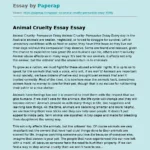Animal cruelty is an insidious issue that pervades societies worldwide, and the Philippines is no exception to this disheartening reality. Defined broadly, animal cruelty refers to the infliction of suffering, neglect, or harm upon animals. In the archipelago, various forms of cruelty span from overt violence to systemic neglect, often exacerbated by cultural attitudes and economic challenges.
In many rural communities, animals are relied upon for labor and sustenance, leading some to view them merely as property rather than sentient beings deserving of compassion. This utilitarian perspective often cultivates an environment where abuse is normalized—whether through physical harm or deprivation of basic needs like food, shelter, and veterinary care. Moreover, urban areas face their own version of cruelty, characterized by the laments of stray animals suffering in silence on sprawling streets. The plight of these voiceless beings is often overlooked, creating a pervasive culture of apathy.
One of the foremost challenges in combating animal cruelty in the Philippines is the lack of stringent enforcement of existing laws. The Animal Welfare Act of 1998 is a legislative cornerstone aimed at protecting animals from abuse and neglect. However, its implementation remains tepid, often hampered by insufficient resources, a lack of awareness, and the societal perception that animals do not require the same moral consideration as humans. This legal shortcoming creates a void, allowing abominable acts to go unpunished.
Moreover, economic constraints act as a barrier to effective animal advocacy. In a country where poverty is rampant, humane treatment of animals is frequently sidelined in favor of immediate human needs. For many, the focus remains largely on survival, where the welfare of animals is not a priority. This reality poses a moral dilemma—should resources be allocated to animal welfare when a significant portion of the population struggles to meet their basic human needs? There exists a dichotomy, where funds meant for sheltering stray dogs often find themselves redirected to feeding the homeless.
Additionally, cultural beliefs and practices play a pivotal role in shaping attitudes toward animals. In certain contexts, indigenous traditions may promote activities that are detrimental to animal welfare, such as dog fighting or cockfighting—practices steeped in history yet incongruous with modern ethical standards. Changing the narrative to foster a culture of compassion rather than exploitation necessitates ongoing education and community engagement to elevate collective consciousness regarding animal rights.
Despite these challenges, a burgeoning movement for animal welfare is sweeping across the Philippines, emboldening activists and concerned citizens to take a stand against cruelty. Organizations dedicated to rescuing abused animals and providing education are increasingly vocal. Their efforts extend beyond mere rescue operations; they aim to instill a sense of responsibility toward animal welfare in communities, advocating for sterilization programs to control stray populations and promote responsible pet ownership.
Advocacy plays a critical role in shifting perspectives on animal rights. Through campaigns, social media, and community outreach, animal welfare proponents are gradually igniting conversations that once lay dormant. Engaging youth through educational programs has proven particularly effective. The youth of today are not merely passive observers; they exhibit a palpable passion for change, often serving as catalysts within their communities. Initiatives that encourage discussions around animal rights in schools can have lasting impacts, cultivating a generation that values empathy and respect for all living beings.
Furthermore, the collaboration between local and international organizations has magnified the reach of advocacy efforts. Sharing resources and expertise allows groups to effectively address the myriad facets of animal cruelty. International partnerships also bring attention to the urgent need for reform and provide logistical support for animal welfare initiatives on the ground. This symbiotic relationship fosters a comprehensive approach to tackle the challenges inherent in animal rights advocacy in the Philippines.
The media, too, plays an indispensable role in this burgeoning movement. The proliferation of digital platforms allows animal rights activists to shine a spotlight on instances of cruelty. Viral videos showcasing the stark realities of neglected and abused animals have the power to provoke emotional responses and ignite public outrage. Such visibility compels action—not only through donations and volunteer efforts but also by pressuring governmental bodies to take their legislative and protective responsibilities seriously.
Finally, an integral aspect of advancing animal rights involves the promotion of ethical consumption. As awareness spreads about the distasteful conditions under which certain products—such as meat and leather—are produced, many are reevaluating their purchasing decisions. The growing popularity of vegetarian and vegan lifestyles within urban centers reflects a significant shift in consumer attitudes. Conscious choices resonate beyond individual lifestyles, fostering a cultural shift toward humane practices and sustainable living.
In conclusion, the fight against animal cruelty in the Philippines is complex and multi-faceted. While significant challenges remain, a growing network of advocates exemplifies the potential for transformative change. Through continued education, legal reform, and collaborative endeavors, a hopeful narrative is emerging—one where compassion toward all beings becomes not just an ideal but a practiced reality. The quest for animal rights is an invitation to introspect, to confront uncomfortable truths, and ultimately, to unify under the banner of empathy and respect for every living creature.








